Financial Decision-Making: Analysis of Investment Appraisal Techniques
VerifiedAdded on 2023/01/07
|8
|1481
|99
Report
AI Summary
This report delves into the crucial realm of business decision-making, focusing on the application of investment appraisal techniques, specifically Net Present Value (NPV) and payback period, within the context of A&B Plc. The report begins by outlining the importance of accurately identifying the core issue in any business decision-making process and then proceeds to numerically demonstrate the use of these financial tools. The main body of the report includes the computation of the payback period for two projects (Dishwashing and Software), and the calculation of NPV for both projects. The analysis section offers an interpretation of the findings, comparing the effectiveness of each project based on these metrics. The report also discusses the significance of both financial and non-financial factors that influence business decisions, such as gross profit margin, economic growth rate, and competition. The conclusion highlights the importance of investment appraisal in facilitating quick reviews of a business's current position and enabling momentous decisions. The report also offers a discussion of the advantages and disadvantages of both the NPV and payback period methods, and it concludes by emphasizing that NPV is usually preferred by managers as it considers the present value of cash flows. The report includes a list of references to scholarly articles and books that support the analysis.

Business Decision Making
Paraphrase This Document
Need a fresh take? Get an instant paraphrase of this document with our AI Paraphraser

Table of Contents
INTRODUCTION...........................................................................................................................3
MAIN BODY..................................................................................................................................3
1. Computation of payback period:........................................................................................3
2. Calculation of NPV in project A and B:.............................................................................4
3. Analysis..............................................................................................................................5
CONCLUSION...............................................................................................................................6
REFERENCES................................................................................................................................7
INTRODUCTION...........................................................................................................................3
MAIN BODY..................................................................................................................................3
1. Computation of payback period:........................................................................................3
2. Calculation of NPV in project A and B:.............................................................................4
3. Analysis..............................................................................................................................5
CONCLUSION...............................................................................................................................6
REFERENCES................................................................................................................................7
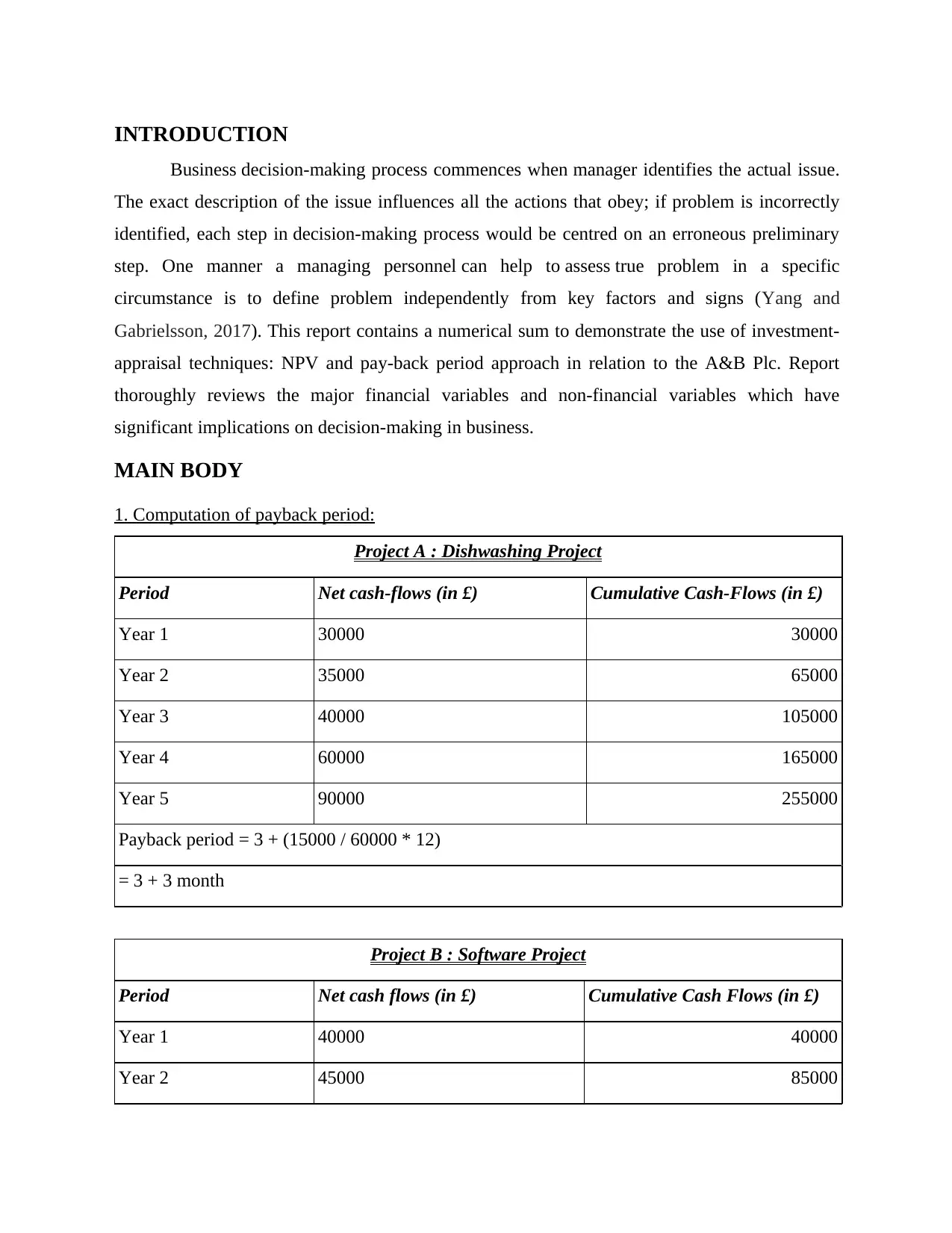
INTRODUCTION
Business decision-making process commences when manager identifies the actual issue.
The exact description of the issue influences all the actions that obey; if problem is incorrectly
identified, each step in decision-making process would be centred on an erroneous preliminary
step. One manner a managing personnel can help to assess true problem in a specific
circumstance is to define problem independently from key factors and signs (Yang and
Gabrielsson, 2017). This report contains a numerical sum to demonstrate the use of investment-
appraisal techniques: NPV and pay-back period approach in relation to the A&B Plc. Report
thoroughly reviews the major financial variables and non-financial variables which have
significant implications on decision-making in business.
MAIN BODY
1. Computation of payback period:
Project A : Dishwashing Project
Period Net cash-flows (in £) Cumulative Cash-Flows (in £)
Year 1 30000 30000
Year 2 35000 65000
Year 3 40000 105000
Year 4 60000 165000
Year 5 90000 255000
Payback period = 3 + (15000 / 60000 * 12)
= 3 + 3 month
Project B : Software Project
Period Net cash flows (in £) Cumulative Cash Flows (in £)
Year 1 40000 40000
Year 2 45000 85000
Business decision-making process commences when manager identifies the actual issue.
The exact description of the issue influences all the actions that obey; if problem is incorrectly
identified, each step in decision-making process would be centred on an erroneous preliminary
step. One manner a managing personnel can help to assess true problem in a specific
circumstance is to define problem independently from key factors and signs (Yang and
Gabrielsson, 2017). This report contains a numerical sum to demonstrate the use of investment-
appraisal techniques: NPV and pay-back period approach in relation to the A&B Plc. Report
thoroughly reviews the major financial variables and non-financial variables which have
significant implications on decision-making in business.
MAIN BODY
1. Computation of payback period:
Project A : Dishwashing Project
Period Net cash-flows (in £) Cumulative Cash-Flows (in £)
Year 1 30000 30000
Year 2 35000 65000
Year 3 40000 105000
Year 4 60000 165000
Year 5 90000 255000
Payback period = 3 + (15000 / 60000 * 12)
= 3 + 3 month
Project B : Software Project
Period Net cash flows (in £) Cumulative Cash Flows (in £)
Year 1 40000 40000
Year 2 45000 85000
⊘ This is a preview!⊘
Do you want full access?
Subscribe today to unlock all pages.

Trusted by 1+ million students worldwide
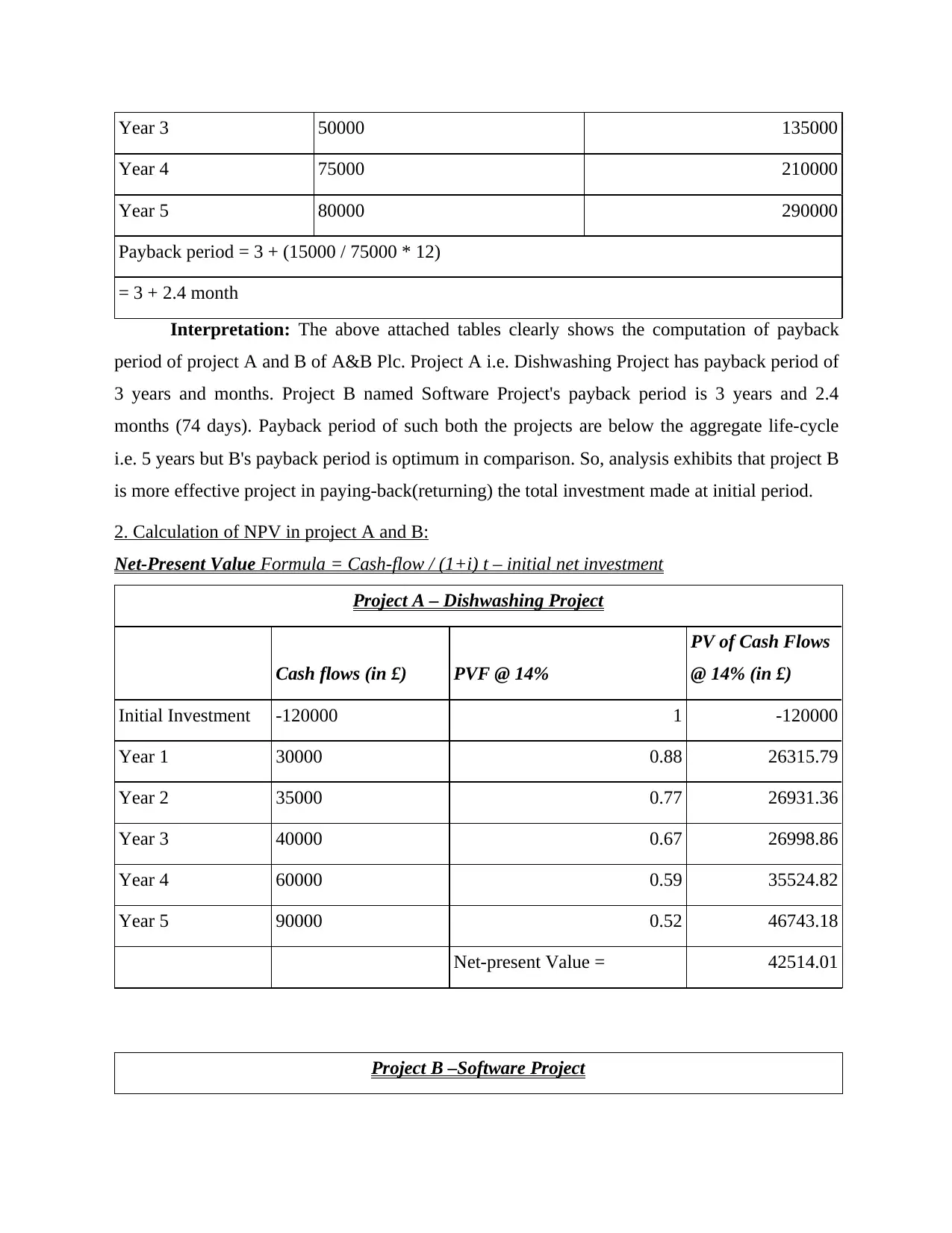
Year 3 50000 135000
Year 4 75000 210000
Year 5 80000 290000
Payback period = 3 + (15000 / 75000 * 12)
= 3 + 2.4 month
Interpretation: The above attached tables clearly shows the computation of payback
period of project A and B of A&B Plc. Project A i.e. Dishwashing Project has payback period of
3 years and months. Project B named Software Project's payback period is 3 years and 2.4
months (74 days). Payback period of such both the projects are below the aggregate life-cycle
i.e. 5 years but B's payback period is optimum in comparison. So, analysis exhibits that project B
is more effective project in paying-back(returning) the total investment made at initial period.
2. Calculation of NPV in project A and B:
Net-Present Value Formula = Cash-flow / (1+i) t – initial net investment
Project A – Dishwashing Project
Cash flows (in £) PVF @ 14%
PV of Cash Flows
@ 14% (in £)
Initial Investment -120000 1 -120000
Year 1 30000 0.88 26315.79
Year 2 35000 0.77 26931.36
Year 3 40000 0.67 26998.86
Year 4 60000 0.59 35524.82
Year 5 90000 0.52 46743.18
Net-present Value = 42514.01
Project B –Software Project
Year 4 75000 210000
Year 5 80000 290000
Payback period = 3 + (15000 / 75000 * 12)
= 3 + 2.4 month
Interpretation: The above attached tables clearly shows the computation of payback
period of project A and B of A&B Plc. Project A i.e. Dishwashing Project has payback period of
3 years and months. Project B named Software Project's payback period is 3 years and 2.4
months (74 days). Payback period of such both the projects are below the aggregate life-cycle
i.e. 5 years but B's payback period is optimum in comparison. So, analysis exhibits that project B
is more effective project in paying-back(returning) the total investment made at initial period.
2. Calculation of NPV in project A and B:
Net-Present Value Formula = Cash-flow / (1+i) t – initial net investment
Project A – Dishwashing Project
Cash flows (in £) PVF @ 14%
PV of Cash Flows
@ 14% (in £)
Initial Investment -120000 1 -120000
Year 1 30000 0.88 26315.79
Year 2 35000 0.77 26931.36
Year 3 40000 0.67 26998.86
Year 4 60000 0.59 35524.82
Year 5 90000 0.52 46743.18
Net-present Value = 42514.01
Project B –Software Project
Paraphrase This Document
Need a fresh take? Get an instant paraphrase of this document with our AI Paraphraser
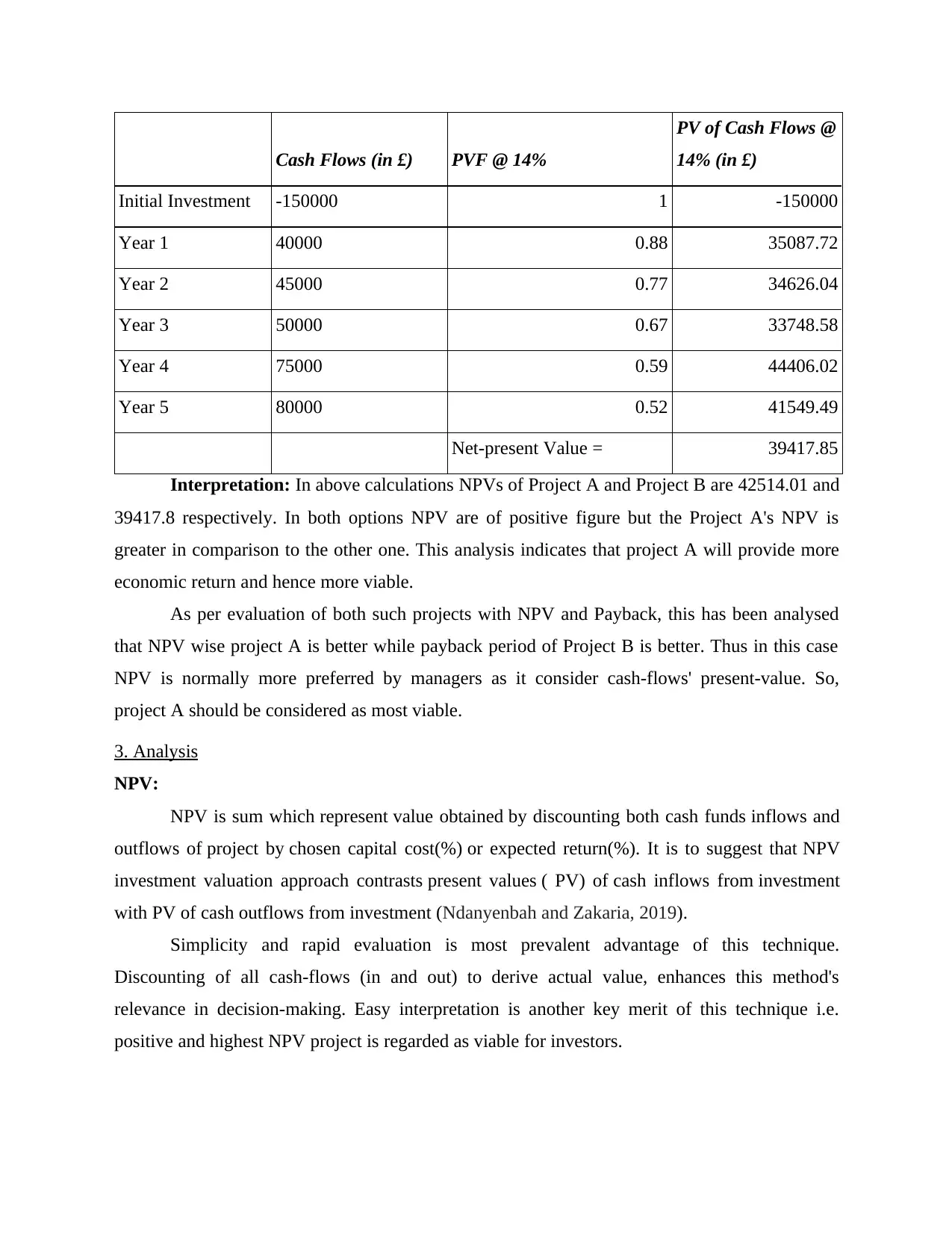
Cash Flows (in £) PVF @ 14%
PV of Cash Flows @
14% (in £)
Initial Investment -150000 1 -150000
Year 1 40000 0.88 35087.72
Year 2 45000 0.77 34626.04
Year 3 50000 0.67 33748.58
Year 4 75000 0.59 44406.02
Year 5 80000 0.52 41549.49
Net-present Value = 39417.85
Interpretation: In above calculations NPVs of Project A and Project B are 42514.01 and
39417.8 respectively. In both options NPV are of positive figure but the Project A's NPV is
greater in comparison to the other one. This analysis indicates that project A will provide more
economic return and hence more viable.
As per evaluation of both such projects with NPV and Payback, this has been analysed
that NPV wise project A is better while payback period of Project B is better. Thus in this case
NPV is normally more preferred by managers as it consider cash-flows' present-value. So,
project A should be considered as most viable.
3. Analysis
NPV:
NPV is sum which represent value obtained by discounting both cash funds inflows and
outflows of project by chosen capital cost(%) or expected return(%). It is to suggest that NPV
investment valuation approach contrasts present values ( PV) of cash inflows from investment
with PV of cash outflows from investment (Ndanyenbah and Zakaria, 2019).
Simplicity and rapid evaluation is most prevalent advantage of this technique.
Discounting of all cash-flows (in and out) to derive actual value, enhances this method's
relevance in decision-making. Easy interpretation is another key merit of this technique i.e.
positive and highest NPV project is regarded as viable for investors.
PV of Cash Flows @
14% (in £)
Initial Investment -150000 1 -150000
Year 1 40000 0.88 35087.72
Year 2 45000 0.77 34626.04
Year 3 50000 0.67 33748.58
Year 4 75000 0.59 44406.02
Year 5 80000 0.52 41549.49
Net-present Value = 39417.85
Interpretation: In above calculations NPVs of Project A and Project B are 42514.01 and
39417.8 respectively. In both options NPV are of positive figure but the Project A's NPV is
greater in comparison to the other one. This analysis indicates that project A will provide more
economic return and hence more viable.
As per evaluation of both such projects with NPV and Payback, this has been analysed
that NPV wise project A is better while payback period of Project B is better. Thus in this case
NPV is normally more preferred by managers as it consider cash-flows' present-value. So,
project A should be considered as most viable.
3. Analysis
NPV:
NPV is sum which represent value obtained by discounting both cash funds inflows and
outflows of project by chosen capital cost(%) or expected return(%). It is to suggest that NPV
investment valuation approach contrasts present values ( PV) of cash inflows from investment
with PV of cash outflows from investment (Ndanyenbah and Zakaria, 2019).
Simplicity and rapid evaluation is most prevalent advantage of this technique.
Discounting of all cash-flows (in and out) to derive actual value, enhances this method's
relevance in decision-making. Easy interpretation is another key merit of this technique i.e.
positive and highest NPV project is regarded as viable for investors.
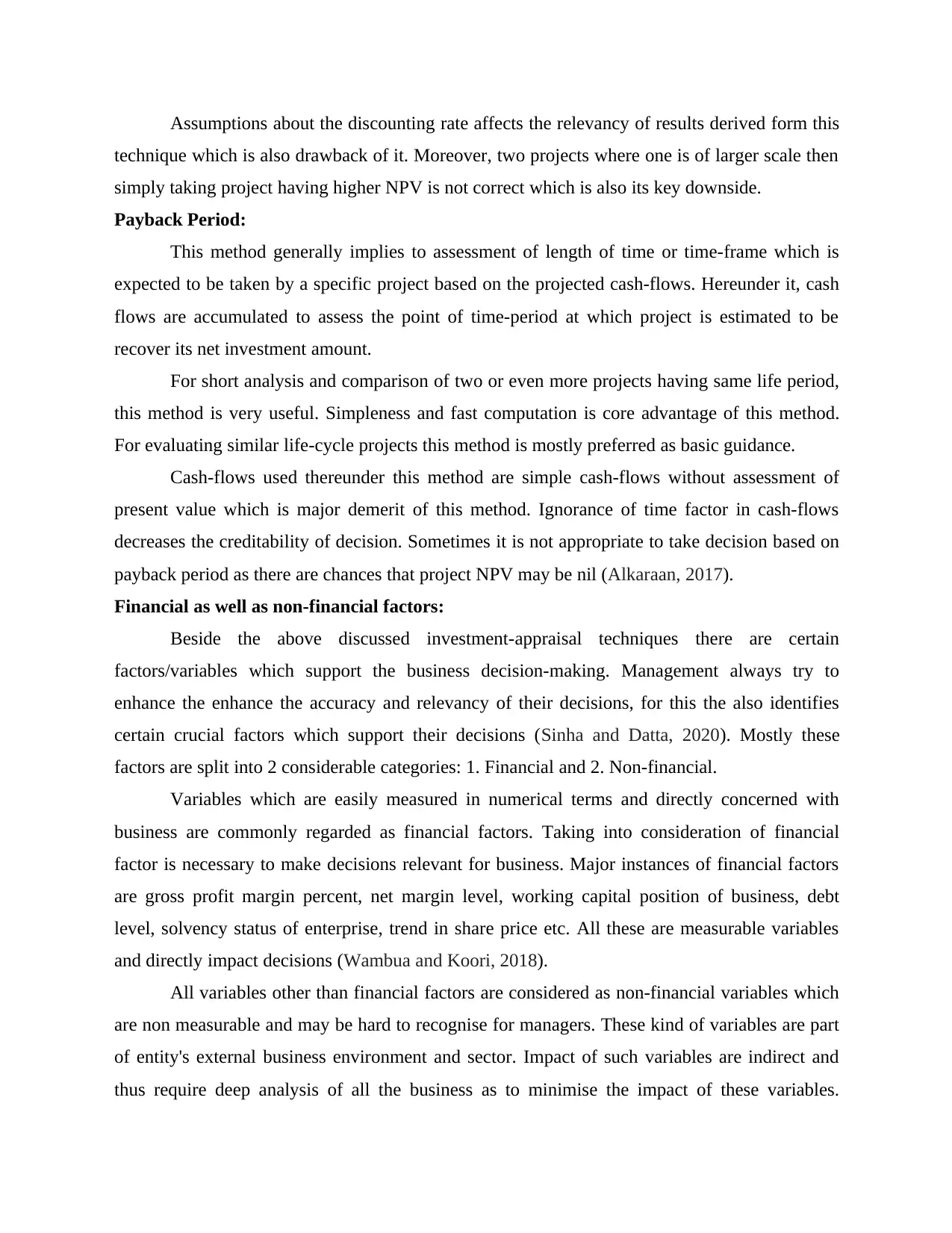
Assumptions about the discounting rate affects the relevancy of results derived form this
technique which is also drawback of it. Moreover, two projects where one is of larger scale then
simply taking project having higher NPV is not correct which is also its key downside.
Payback Period:
This method generally implies to assessment of length of time or time-frame which is
expected to be taken by a specific project based on the projected cash-flows. Hereunder it, cash
flows are accumulated to assess the point of time-period at which project is estimated to be
recover its net investment amount.
For short analysis and comparison of two or even more projects having same life period,
this method is very useful. Simpleness and fast computation is core advantage of this method.
For evaluating similar life-cycle projects this method is mostly preferred as basic guidance.
Cash-flows used thereunder this method are simple cash-flows without assessment of
present value which is major demerit of this method. Ignorance of time factor in cash-flows
decreases the creditability of decision. Sometimes it is not appropriate to take decision based on
payback period as there are chances that project NPV may be nil (Alkaraan, 2017).
Financial as well as non-financial factors:
Beside the above discussed investment-appraisal techniques there are certain
factors/variables which support the business decision-making. Management always try to
enhance the enhance the accuracy and relevancy of their decisions, for this the also identifies
certain crucial factors which support their decisions (Sinha and Datta, 2020). Mostly these
factors are split into 2 considerable categories: 1. Financial and 2. Non-financial.
Variables which are easily measured in numerical terms and directly concerned with
business are commonly regarded as financial factors. Taking into consideration of financial
factor is necessary to make decisions relevant for business. Major instances of financial factors
are gross profit margin percent, net margin level, working capital position of business, debt
level, solvency status of enterprise, trend in share price etc. All these are measurable variables
and directly impact decisions (Wambua and Koori, 2018).
All variables other than financial factors are considered as non-financial variables which
are non measurable and may be hard to recognise for managers. These kind of variables are part
of entity's external business environment and sector. Impact of such variables are indirect and
thus require deep analysis of all the business as to minimise the impact of these variables.
technique which is also drawback of it. Moreover, two projects where one is of larger scale then
simply taking project having higher NPV is not correct which is also its key downside.
Payback Period:
This method generally implies to assessment of length of time or time-frame which is
expected to be taken by a specific project based on the projected cash-flows. Hereunder it, cash
flows are accumulated to assess the point of time-period at which project is estimated to be
recover its net investment amount.
For short analysis and comparison of two or even more projects having same life period,
this method is very useful. Simpleness and fast computation is core advantage of this method.
For evaluating similar life-cycle projects this method is mostly preferred as basic guidance.
Cash-flows used thereunder this method are simple cash-flows without assessment of
present value which is major demerit of this method. Ignorance of time factor in cash-flows
decreases the creditability of decision. Sometimes it is not appropriate to take decision based on
payback period as there are chances that project NPV may be nil (Alkaraan, 2017).
Financial as well as non-financial factors:
Beside the above discussed investment-appraisal techniques there are certain
factors/variables which support the business decision-making. Management always try to
enhance the enhance the accuracy and relevancy of their decisions, for this the also identifies
certain crucial factors which support their decisions (Sinha and Datta, 2020). Mostly these
factors are split into 2 considerable categories: 1. Financial and 2. Non-financial.
Variables which are easily measured in numerical terms and directly concerned with
business are commonly regarded as financial factors. Taking into consideration of financial
factor is necessary to make decisions relevant for business. Major instances of financial factors
are gross profit margin percent, net margin level, working capital position of business, debt
level, solvency status of enterprise, trend in share price etc. All these are measurable variables
and directly impact decisions (Wambua and Koori, 2018).
All variables other than financial factors are considered as non-financial variables which
are non measurable and may be hard to recognise for managers. These kind of variables are part
of entity's external business environment and sector. Impact of such variables are indirect and
thus require deep analysis of all the business as to minimise the impact of these variables.
⊘ This is a preview!⊘
Do you want full access?
Subscribe today to unlock all pages.

Trusted by 1+ million students worldwide
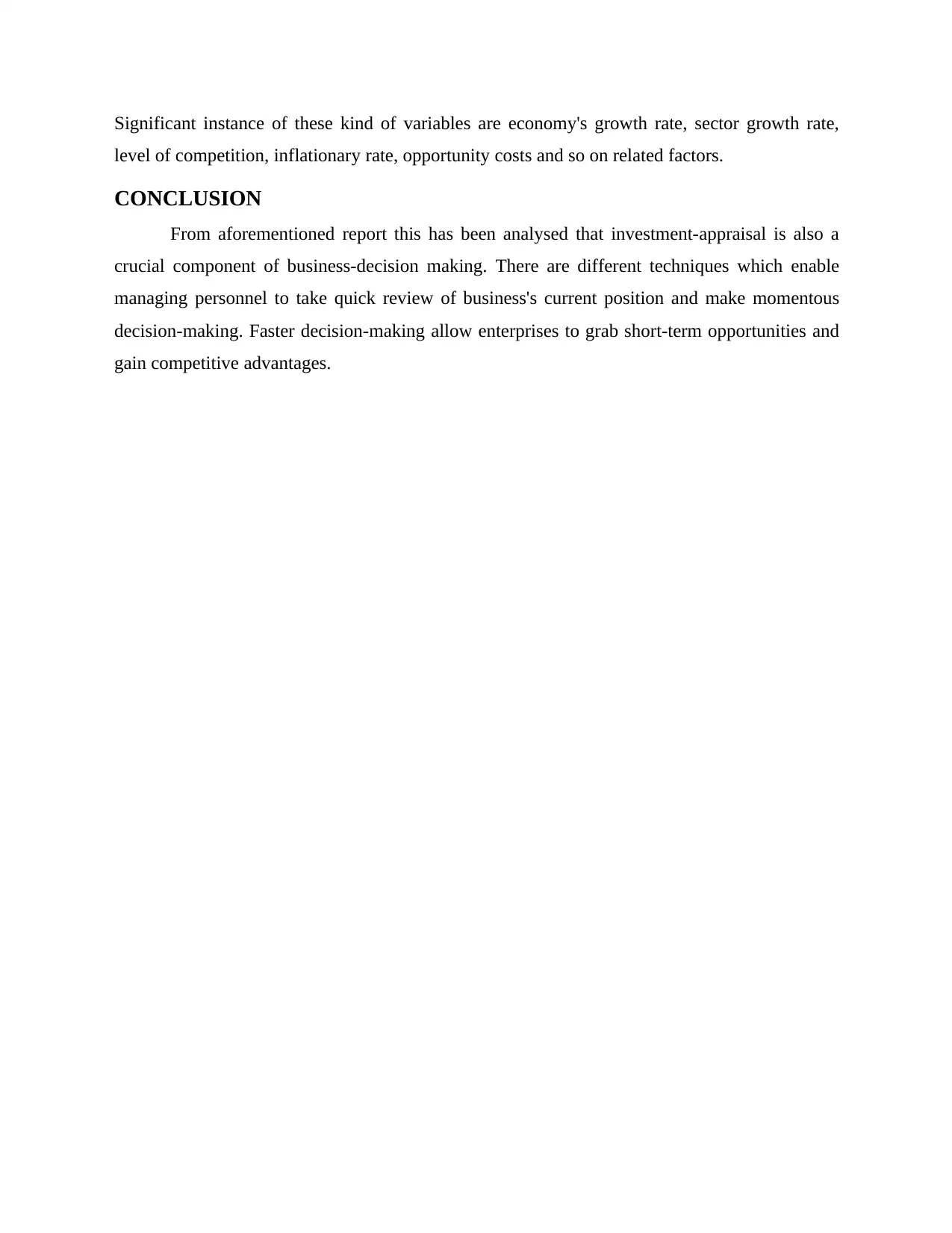
Significant instance of these kind of variables are economy's growth rate, sector growth rate,
level of competition, inflationary rate, opportunity costs and so on related factors.
CONCLUSION
From aforementioned report this has been analysed that investment-appraisal is also a
crucial component of business-decision making. There are different techniques which enable
managing personnel to take quick review of business's current position and make momentous
decision-making. Faster decision-making allow enterprises to grab short-term opportunities and
gain competitive advantages.
level of competition, inflationary rate, opportunity costs and so on related factors.
CONCLUSION
From aforementioned report this has been analysed that investment-appraisal is also a
crucial component of business-decision making. There are different techniques which enable
managing personnel to take quick review of business's current position and make momentous
decision-making. Faster decision-making allow enterprises to grab short-term opportunities and
gain competitive advantages.
Paraphrase This Document
Need a fresh take? Get an instant paraphrase of this document with our AI Paraphraser
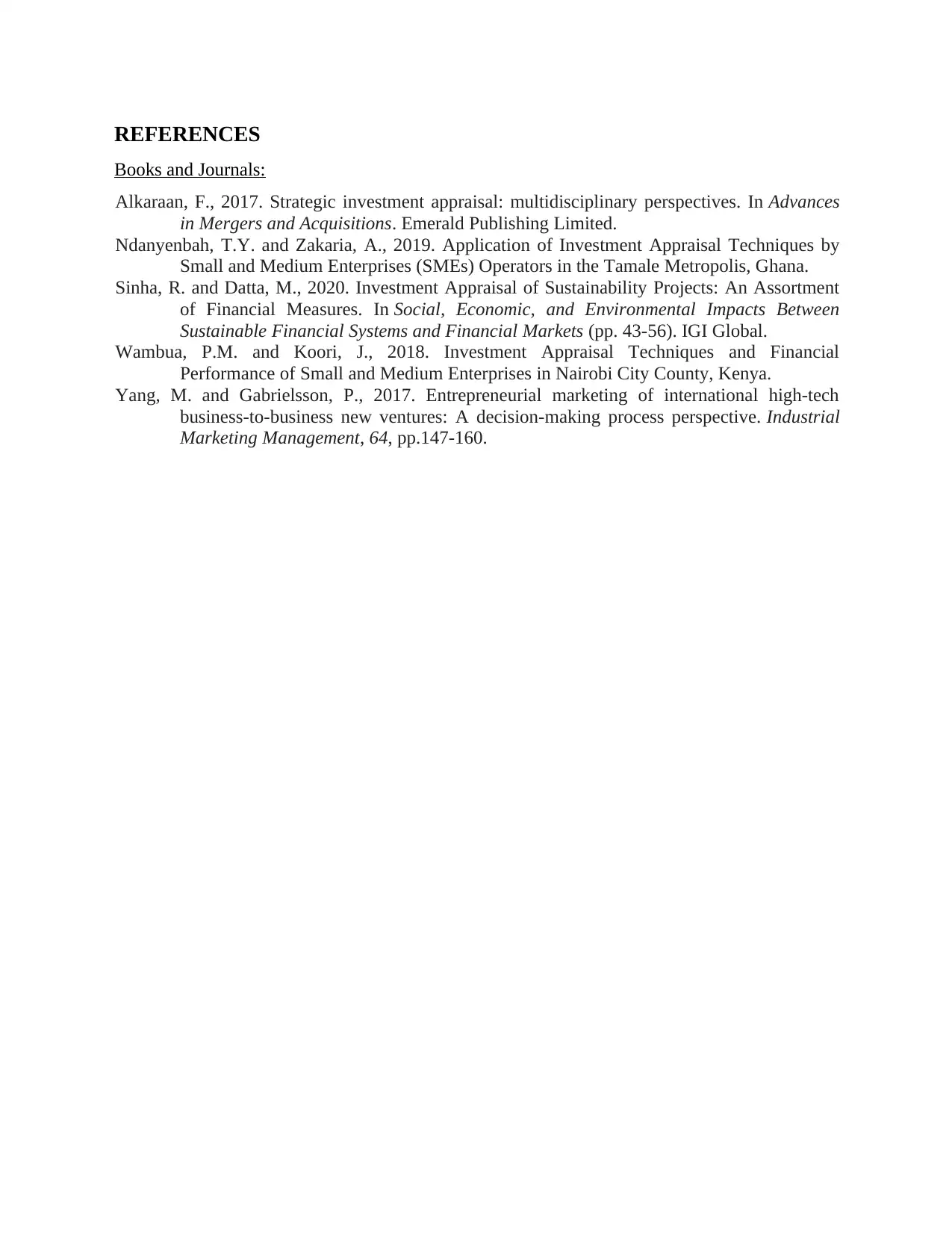
REFERENCES
Books and Journals:
Alkaraan, F., 2017. Strategic investment appraisal: multidisciplinary perspectives. In Advances
in Mergers and Acquisitions. Emerald Publishing Limited.
Ndanyenbah, T.Y. and Zakaria, A., 2019. Application of Investment Appraisal Techniques by
Small and Medium Enterprises (SMEs) Operators in the Tamale Metropolis, Ghana.
Sinha, R. and Datta, M., 2020. Investment Appraisal of Sustainability Projects: An Assortment
of Financial Measures. In Social, Economic, and Environmental Impacts Between
Sustainable Financial Systems and Financial Markets (pp. 43-56). IGI Global.
Wambua, P.M. and Koori, J., 2018. Investment Appraisal Techniques and Financial
Performance of Small and Medium Enterprises in Nairobi City County, Kenya.
Yang, M. and Gabrielsson, P., 2017. Entrepreneurial marketing of international high-tech
business-to-business new ventures: A decision-making process perspective. Industrial
Marketing Management, 64, pp.147-160.
Books and Journals:
Alkaraan, F., 2017. Strategic investment appraisal: multidisciplinary perspectives. In Advances
in Mergers and Acquisitions. Emerald Publishing Limited.
Ndanyenbah, T.Y. and Zakaria, A., 2019. Application of Investment Appraisal Techniques by
Small and Medium Enterprises (SMEs) Operators in the Tamale Metropolis, Ghana.
Sinha, R. and Datta, M., 2020. Investment Appraisal of Sustainability Projects: An Assortment
of Financial Measures. In Social, Economic, and Environmental Impacts Between
Sustainable Financial Systems and Financial Markets (pp. 43-56). IGI Global.
Wambua, P.M. and Koori, J., 2018. Investment Appraisal Techniques and Financial
Performance of Small and Medium Enterprises in Nairobi City County, Kenya.
Yang, M. and Gabrielsson, P., 2017. Entrepreneurial marketing of international high-tech
business-to-business new ventures: A decision-making process perspective. Industrial
Marketing Management, 64, pp.147-160.
1 out of 8
Related Documents
Your All-in-One AI-Powered Toolkit for Academic Success.
+13062052269
info@desklib.com
Available 24*7 on WhatsApp / Email
![[object Object]](/_next/static/media/star-bottom.7253800d.svg)
Unlock your academic potential
Copyright © 2020–2025 A2Z Services. All Rights Reserved. Developed and managed by ZUCOL.





